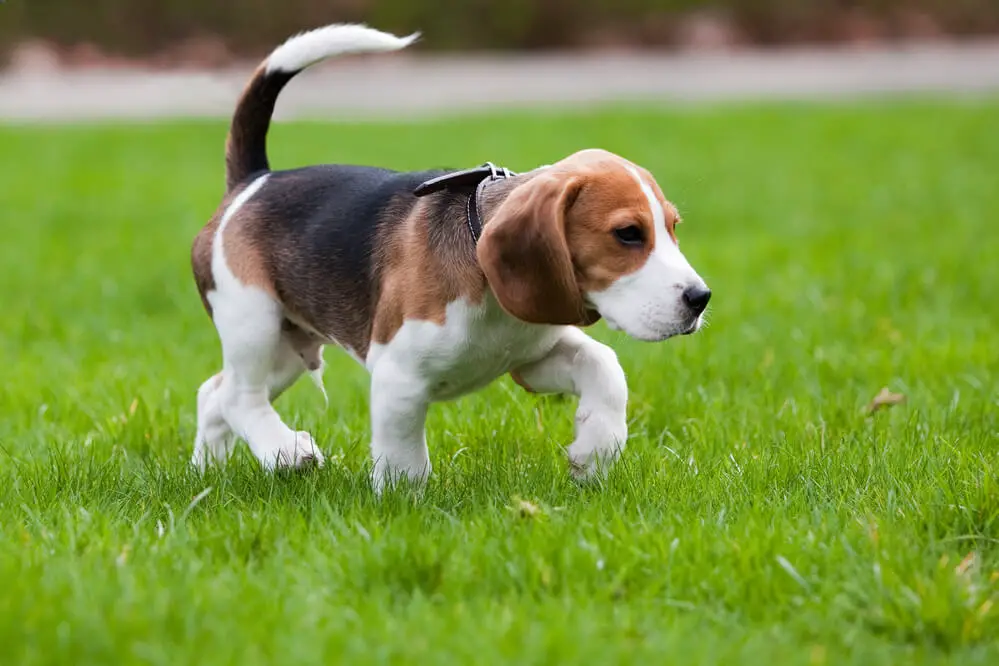Introduction to Beagle Care Guide

Welcome to our comprehensive Beagle care guide. This guide is designed to help you understand the needs of this energetic and loving breed, and provide you with the knowledge to ensure your Beagle lives a happy and healthy life. Beagles are known for their friendly nature and strong sense of smell. They make great family pets, but they do require specific care to keep them at their best.
-
- Understanding the needs of a Beagle
Beagles are a unique breed with specific needs. They are active dogs that require regular exercise to keep them healthy and prevent obesity. They also need mental stimulation due to their intelligent nature. This can be achieved through training, play, and allowing them to use their excellent sense of smell. Beagles are also social animals, so they need plenty of interaction with both humans and other dogs.
-
- Importance of a comprehensive care guide
Having a comprehensive care guide is crucial for any Beagle owner. This is because Beagles have specific needs that differ from other breeds. Without proper care, Beagles can develop health issues like obesity, dental diseases, and ear infections. A comprehensive care guide can help you prevent these issues and ensure your Beagle lives a long and healthy life.
Throughout this guide, we will delve deeper into the specifics of Beagle care, including understanding their unique traits, essential care tips, training best practices, exercise needs, and puppy care. This guide will provide you with all the information you need to give your Beagle the best care possible.
Understanding Beagles: An Overview
Beagles are a popular breed of dog known for their friendly temperament and distinctive appearance. In this section, we will delve into the history and characteristics of this beloved breed to give you a comprehensive understanding of Beagles.
Beagle History and Breed Information
Beagles have a rich history and unique characteristics that make them stand out from other breeds. Let’s explore these aspects in more detail.
-
- Origin of the Beagle breed
The Beagle breed traces its origins back to England in the 1830s. They were initially bred for hunting due to their excellent sense of smell and tracking abilities. The name ‘Beagle’ is believed to have come from the French word ‘be’geule’, which means ‘open throat’, referring to the breed’s distinctive howl. For more detailed information, you can visit the Beagle page on Wikipedia.
-
- Characteristics of Beagles
Beagles are small to medium-sized dogs, typically weighing between 20 to 30 pounds. They have a short coat that comes in a variety of colors, including tri-color, black and tan, and lemon. Beagles are known for their large, floppy ears and expressive brown or hazel eyes. They have a strong, muscular body that is built for endurance and agility. Beagles are also known for their keen sense of smell, which is second only to the Bloodhound. This trait makes them excellent tracking dogs.
In the next section, we will delve into the temperament and behavior of Beagles, which is an essential aspect to understand if you are considering adopting or buying a Beagle.
Beagle Temperament and Behavior
Beagles are known for their friendly and gentle temperament, making them a popular choice for families. However, understanding their behavior is crucial for a harmonious relationship. Let’s delve into the common behaviors and temperament of Beagles.
-
- Common Beagle Behaviors
Beagles are a breed full of energy and curiosity. They are known for their love of exploration, often following their noses which can sometimes lead them astray. Here are some common behaviors you might observe in your Beagle:
-
-
- Chasing Scents: Beagles were bred as scent hounds and have an excellent sense of smell. They often get distracted by interesting smells and may wander off to investigate.
- Barking and Howling: Beagles are vocal dogs. They have a distinctive howl or bay which they use when they are bored, excited, or have found something interesting.
- Playfulness: Beagles are very playful and enjoy games and activities. They love to play fetch and will happily spend hours playing with their favorite toys.
- Food Motivated: Beagles love food and can be easily trained using treats as motivation. However, care should be taken to prevent overfeeding.
- Understanding Beagle Temperament
-
The Beagle temperament is typically friendly, outgoing, and sociable. They get along well with other dogs and humans, making them a great choice for families. However, they can be stubborn at times, especially when a scent has caught their attention. Here are some key points to understand their temperament:
-
- Friendly: Beagles are known for their friendly and amiable nature. They are great with kids and make excellent family pets.
- Stubborn: While Beagles are generally easy to train, they can be stubborn at times. This is particularly true when they are on the scent trail.
- Curious: Beagles are naturally curious dogs. They love to explore their surroundings and will often follow their noses to investigate new scents.
- Active: Beagles are active dogs that require regular exercise to keep them healthy and happy. They love to play and will enjoy long walks or runs.
In conclusion, understanding your Beagle’s behavior and temperament will help you provide them with the best care and training. Remember, every Beagle is unique and may not display all of these behaviors or traits. It’s important to get to know your Beagle as an individual and adjust your care accordingly.
How to Care for Beagles: Essential Tips
Beagle owners know that these energetic, friendly dogs require special care to keep them healthy and happy. In this section, we will delve into the essential aspects of Beagle health care, including common health issues, the importance of regular vet check-ups, and the recommended vaccination and deworming schedule.
Beagle Health Care
Proper health care is crucial for your Beagle’s well-being. Let’s explore some key elements:
-
- Common health issues in Beagles
Beagles are generally healthy dogs, but they can be prone to certain health issues. These include obesity, epilepsy, hypothyroidism, and hip dysplasia. Regular check-ups can help detect these issues early. For more in-depth information, you can visit the Beagle Health section on Wikipedia.
-
- Regular vet check-ups
Regular vet visits are essential for your Beagle’s health. These check-ups can help catch any potential health issues early, ensuring your Beagle gets the necessary treatment promptly. It’s recommended to take your Beagle for a vet check-up at least once a year.
-
- Vaccination and deworming schedule
Keeping up with your Beagle’s vaccination and deworming schedule is vital to prevent serious diseases. Puppies should be vaccinated at 6, 9, 12, and 16 weeks old, and then annually. Deworming should be done every 3 months. Always consult with your vet to establish the best schedule for your Beagle.
In conclusion, taking care of your Beagle’s health involves being proactive about regular check-ups, staying on top of vaccinations and deworming, and being aware of common health issues. With proper care, your Beagle can lead a healthy, happy life.
Feeding a Beagle
Feeding your Beagle properly is crucial for their health and well-being. Let’s discuss the recommended diet for Beagles and the ideal feeding schedule and portion sizes.
-
- Recommended diet for Beagles
Beagles, like all dogs, require a balanced diet to stay healthy. This includes proteins, carbohydrates, fats, vitamins, and minerals. The primary source of their diet should be high-quality, animal-based proteins such as chicken, beef, or fish. Carbohydrates provide energy and should come from wholesome sources like sweet potatoes or brown rice. Fats are essential for skin and coat health, and sources can include fish oil or flaxseed. Lastly, fruits and vegetables can provide necessary vitamins and minerals.
It’s also important to note that Beagles are prone to obesity, so avoid feeding them table scraps or excessive treats. Always opt for dog-specific treats and make sure they make up no more than 10% of your Beagle’s daily caloric intake.
-
- Feeding schedule and portion sizes
Beagles should be fed two meals per day, one in the morning and one in the evening. This helps to regulate their metabolism and prevent overeating. The portion size will depend on their age, size, and activity level.
| Age | Size | Activity Level | Recommended Portion Size |
|---|---|---|---|
| Puppy (2-6 months) | Small | High | 1-1.5 cups per meal |
| Adult (1-7 years) | Medium | Moderate | 1.5-2 cups per meal |
| Senior (8+ years) | Medium | Low | 1-1.5 cups per meal |
Remember, these are just guidelines. Always consult with your vet to determine the best diet and feeding schedule for your specific Beagle.
Beagle Grooming Tips
Proper grooming is an essential part of caring for your Beagle. It’s not just about keeping them looking good, but also about maintaining their health and happiness. Here are some key grooming tips that every Beagle owner should know:
- Regular brushing and bathing: Beagles have a short coat that’s relatively easy to care for. However, they are known for their love of rolling in anything they find interesting, which can often be quite messy! Regular brushing helps to remove loose hair and keep their coat healthy. It’s recommended to brush your Beagle at least once a week. Bathing should be done once a month or whenever your Beagle gets particularly dirty. Always use a dog-friendly shampoo to avoid irritating their skin. Learn more about dog brushing and bathing here.
- Nail care and ear cleaning: Beagles have a tendency to develop ear infections due to their long, floppy ears. Regular ear cleaning can help prevent this. Check your Beagle’s ears once a week for any signs of redness, irritation, or bad odor. If you notice anything unusual, consult your vet. Nail care is also important. If your Beagle’s nails get too long, it can cause discomfort or even injury. It’s recommended to trim their nails every 3-4 weeks. If you’re unsure about how to do this, your vet or a professional groomer can help. Learn more about dog ear care here.
Remember, grooming is also a great opportunity to check your Beagle for any signs of health issues, like skin problems or lumps. It’s also a wonderful way to bond with your pet. Happy grooming!
Training a Beagle: Best Practices
Training your Beagle is an essential part of their care and development. Not only does it help in managing their behavior, but it also strengthens your bond with them. Let’s delve into some basic obedience training practices.
Basic Obedience Training
Basic obedience training is the foundation for a well-behaved Beagle. This involves teaching them basic commands and house training.
-
Teaching Basic Commands
Start with simple commands like ‘Sit’, ‘Stay’, ‘Come’, and ‘Leave it’. Beagles are intelligent and eager to please, making them relatively easy to train. However, they can also be stubborn, so patience and consistency are key. Use positive reinforcement such as treats, praise, and petting to reward your Beagle when they follow a command correctly.
For example, to teach your Beagle to ‘Sit’, hold a treat above their nose, then move it over their head. As their head goes up to follow the treat, their bottom will go down. Once they’re sitting, say ‘Sit’, give them the treat and share affection.
-
House Training Your Beagle
House training is another crucial part of basic obedience training. This involves teaching your Beagle to eliminate outside or in a designated indoor area. Start house training as soon as you bring your Beagle home. Remember, consistency and patience are key.
Establish a routine for feeding and potty breaks. Take your Beagle out first thing in the morning, after meals, after naps, and before bedtime. Always take them to the same spot for elimination. When they do their business, give them a treat and lots of praise.
If accidents happen, clean up thoroughly to remove the scent and discourage them from using the same spot again. Never punish your Beagle for accidents. Instead, redirect them to the correct spot and reward them for using it.
Remember, training a Beagle takes time and patience, but the results are well worth it. A well-trained Beagle is a joy to live with and a proud member of the family.
Beagle Behavior Management
Managing the behavior of your Beagle is an essential part of their training. Beagles are known for their energetic and curious nature, which can sometimes lead to behavioral issues. However, with the right approach, you can effectively address these problems and foster a positive relationship with your pet.
-
- Addressing common behavior problems
Beagles are often prone to certain behavior problems such as excessive barking, digging, and chewing. These behaviors are usually a result of boredom or lack of exercise. To address these issues, ensure your Beagle gets plenty of physical activity and mental stimulation. Provide them with chew toys to keep them occupied and discourage destructive behavior. If the problem persists, consider seeking professional help from a dog behaviorist. Remember, patience and consistency are key when dealing with behavior problems. Learn more about dog behavior here.
-
- Positive reinforcement techniques
Positive reinforcement is a powerful tool in managing your Beagle’s behavior. This technique involves rewarding your dog for good behavior, which encourages them to repeat it. Rewards can be in the form of treats, praise, or extra playtime. For instance, if your Beagle sits on command, give them a treat and praise them. This will make them associate sitting on command with positive outcomes, making them more likely to do it again. Remember, timing is crucial in positive reinforcement. Reward your Beagle immediately after they display the desired behavior for the best results. Learn more about positive reinforcement here.
Beagle Exercise Needs
Beagles are a breed of dog known for their energy and love of play. As such, they require a significant amount of exercise to stay healthy and happy. Let’s delve into the specifics of their exercise needs.
-
- Recommended Daily Exercise
Beagles are an active and energetic breed that requires at least 1 hour of exercise per day, but more is often better. This exercise can be broken up into several shorter sessions or done all at once. It’s important to remember that the exercise should be engaging and fun for your Beagle, not just a chore. Walking, running, and playing fetch are all great ways to keep your Beagle active.
-
- Fun Activities for Beagles
Beagles are known for their keen sense of smell and love of exploration. This makes activities like scent games and treasure hunts a great way to keep them entertained and active. You can hide treats around your home or yard and let your Beagle sniff them out. They also enjoy agility training, which not only provides physical exercise but also mental stimulation. Other fun activities include swimming, hiking, and playing with other dogs. Remember, the key is to make exercise fun and engaging for your Beagle.
Exercise is a crucial part of a Beagle’s care and contributes significantly to their overall health and well-being. By ensuring your Beagle gets the recommended amount of daily exercise and engaging them in fun activities, you can help keep them happy, healthy, and active.
For more information on Beagles and their care, you can visit the Beagle page on Wikipedia.
Beagle Puppy Care
Bringing a Beagle puppy into your home is an exciting experience. However, it requires careful planning and preparation. Here, we will guide you through the process of preparing for a Beagle puppy.
Preparing for a Beagle Puppy
Before you bring your new Beagle puppy home, there are two main areas you need to focus on: setting up your home and choosing the right puppy supplies.
-
- Setting up your home
First and foremost, you need to ensure your home is puppy-proof. Beagles are known for their curiosity and love for exploration. Therefore, it’s essential to remove any hazardous items that your puppy might chew or swallow. Secure loose wires, remove toxic plants, and ensure all small objects are out of reach. Also, designate a specific area for your puppy, complete with a comfortable bed and toys.
-
- Choosing the right puppy supplies
When it comes to supplies, you’ll need to invest in quality food, a sturdy leash, a comfortable collar, and a variety of toys. Beagles are active dogs, so toys that stimulate their minds and encourage physical activity are a great choice. Additionally, consider purchasing a crate for house training and a set of grooming supplies for maintaining your Beagle’s coat and nails.
Remember, preparing for a Beagle puppy is not just about buying supplies and puppy-proofing your home. It’s also about preparing yourself for the responsibility of caring for a new life. Beagles are energetic and require plenty of exercise and mental stimulation. Make sure you’re ready for the commitment before bringing a Beagle puppy into your home.
Caring for a Beagle Puppy
Bringing a Beagle puppy into your home is an exciting experience. However, it also comes with a set of responsibilities. Let’s look at two crucial aspects of Beagle puppy care: feeding and grooming, and introducing your puppy to training and socialization.
-
Puppy Feeding and Grooming
Feeding your Beagle puppy a balanced diet is essential for their growth and development. Puppies should be fed 3-4 times a day with high-quality puppy food. Make sure to provide fresh water at all times. Here is a reliable source for more information on dog nutrition.
Grooming is also an integral part of your puppy’s care. Regular brushing helps keep their coat healthy and reduces shedding. Beagles are known for their short, dense coat that requires minimal grooming. However, they can be prone to ear infections due to their long, floppy ears. Regular ear checks and cleaning can help prevent this.
-
Introducing Your Puppy to Training and Socialization
Training should start as soon as your Beagle puppy settles into your home. Start with basic commands like ‘sit’, ‘stay’, and ‘come’. Beagles are intelligent but can be stubborn, so patience and consistency are key. Reward-based training methods work best with this breed.
Socialization is equally important. Expose your puppy to different environments, people, and other animals to help them become well-adjusted adults. Puppy classes or playdates can be a great way to start. Remember, early socialization can help prevent behavioral issues in the future.
In conclusion, caring for a Beagle puppy requires dedication and patience. But with the right approach, you can ensure your puppy grows into a healthy, happy, and well-behaved dog.
Conclusion: Enjoying Life with Your Beagle
As we conclude our comprehensive guide on Beagle care, it’s important to remember that owning a Beagle is not just about the responsibilities. It’s also about the joy, the companionship, and the unique bond that you and your furry friend will share. Let’s summarize the key points.
-
- Embracing the joys and challenges of Beagle ownership: Beagles are known for their lively spirit and friendly nature. They are excellent companions and can bring immense joy to your life. However, they also come with their own set of challenges. Beagles are energetic and require regular exercise. They are also known for their stubbornness, which can make training a bit tricky. But with patience, consistency, and a lot of love, you can overcome these challenges and enjoy a rewarding relationship with your Beagle.
- Continued learning and adaptation: Owning a Beagle is a continuous learning experience. As your Beagle grows and changes, so will their needs. It’s important to stay informed and adapt to these changes. Regular vet check-ups, staying up-to-date with the latest in Beagle care, and being attentive to your Beagle’s behavior can help you ensure that your Beagle is happy and healthy. Remember, a well-cared-for Beagle is a happy Beagle.
In conclusion, owning a Beagle can be one of the most rewarding experiences of your life. They are not just pets, but family. And like any family member, they require care, love, and understanding. So embrace the journey, learn from the challenges, and enjoy every moment with your Beagle.
For more information on Beagles, visit Wikipedia.








